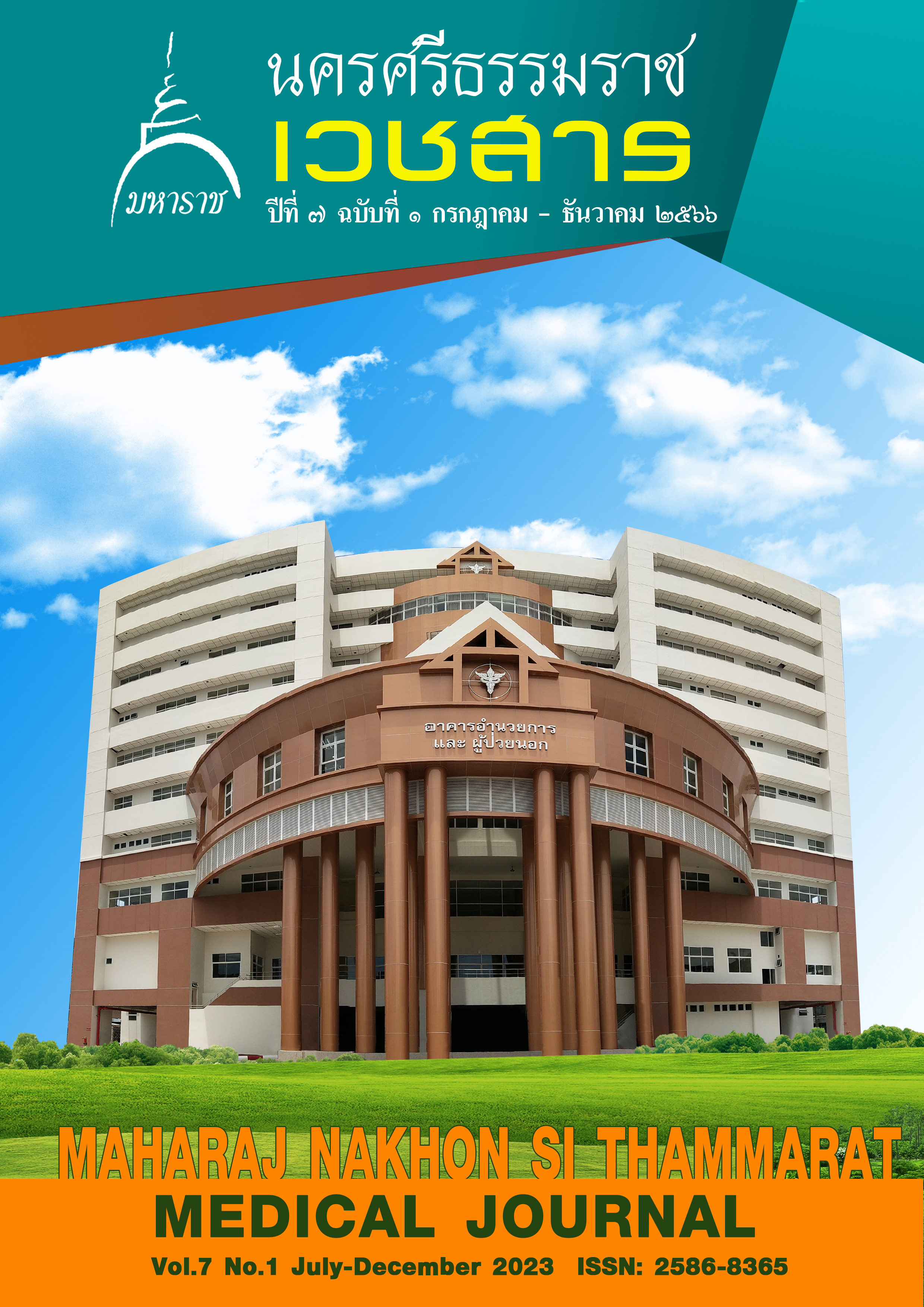ปัจจัยที่มีผลต่อการเกิดไตวายเรื้อรังและการเสียชีวิตในผู้ป่วยไตวายเฉียบพลัน ที่ได้รับการบำบัดทดแทนไตในโรงพยาบาลทุ่งสง
คำสำคัญ:
ไตวายเฉียบพลัน, บำบัดทดแทนไต, ไตวายเรื้อรัง, การเสียชีวิตบทคัดย่อ
บทนำ : ภาวะไตวายเฉียบพลันเป็นภาวะที่พบได้บ่อยในเวชปฏิบัติ และนำไปสู่ภาวะทุพภาพต่าง ๆ รวมถึงการเพิ่มอัตราการเสียชีวิต การศึกษานี้เพื่อศึกษาปัจจัยที่ส่งผลไปสู่การเกิดไตวายเรื้อรังและการเสียชีวิต ในผู้ป่วยไตวายเฉียบพลันที่ได้รับการบำบัดทดแทนไต
วัตถุประสงค์ : เพื่อศึกษาปัจจัยต่างๆ ที่มีผลต่อการเกิดไตวายเรื้อรังและการเสียชีวิตในผู้ป่วยไตวายเฉียบพลันที่ได้รับการบำบัดทดแทนไตในโรงพยาบาลทุ่งสง
วิธีการศึกษา : เป็นการศึกษาย้อนหลัง โดยทบทวนเวชระเบียนผู้ป่วยไตวายเฉียบพลันทุกรายที่เข้ารับการบำบัดทดแทนไตที่หน่วยไตเทียม โรงพยาบาลทุ่งสง ตั้งแต่กรกฎาคม พ.ศ. 2559 จนถึง กรกฎาคม พ.ศ. 2564 และติดตามผู้ป่วยเป็นระยะเวลา 3 เดือน
ผลการศึกษา : ผู้ป่วยที่ต้องทำการบำบัดทดแทนไต 161 ราย อายุเฉลี่ย 59.06±15.72 ปี โดยพบว่าอัตราการเสียชีวิต และอัตราการบำบัดทดแทนไตต่อเนื่อง อยู่ที่ 46 ราย (ร้อยละ 28.6) และ 52 ราย (ร้อยละ 32) ตามลำดับ ปัจจัยที่มีผลต่ออัตราการเสียชีวิตในผู้ป่วยกลุ่มดังกล่าว ได้แก่ อายุที่เยอะมากกว่า 80 ปี (aOR, 1.04; 95%CI, 1.01-1.08, มีภาวะติดเชื้อ (aOR, 1.45; 95%CI, 1.58-3.63, มีการใช้ยากระตุ้น (aOR, 2.27; 95%CI, 2.66-7.82, และการมีโรคร่วมที่มากกว่า 3 โรคขึ้นไป (aOR, 3.21; 95%CI, 2.12-3.56, ส่วนปัจจัยที่มีผลต่อการเกิดไตวายเรื้อรังในผู้ป่วยกลุ่มดังกล่าว ได้แก่ ค่าการทำงานของไตที่สูงอยู่เดิม (aOR, 2.24; 95%CI, 1.11-4.53, มีภาวะซีดระดับฮีโมโกบินน้อยกว่า 10 มิลกรัมต่อเดซิลิตร (aOR, 1.36; 95%CI, 1.45-4.09,ร่วมกับขนาดไตที่เล็กจากการทำอัลตราซาวน์น้อยกว่า 8.5 เซนติเมตร (aOR, 1.13; 95%CI, 1.34-3.73,
สรุป : การศึกษานี้พบว่า อัตราการเสียชีวิตในผู้ป่วยไตวายเฉียบพลันที่ได้รับการบำบัดทดแทนไตสูง ร้อยละ 28โดยอายุที่เยอะ การติดเชื้อ การใช้ยากระตุ้น และการมีโรคร่วม จะสัมพันธ์กับอัตราการตายที่สูงขึ้น
คำสำคัญ : ไตวายเฉียบพลัน บำบัดทดแทนไต ไตวายเรื้อรัง การเสียชีวิต
เอกสารอ้างอิง
Forni LG, Darmon M, Ostermann M, Oudemans-van Straaten HM, Pettila V, Prowle JR, et al. Renal recovery after acute kidney injury. Intensive Care Med 2017;43:855-66.
See EJ, Jayasinghe K, Glassford N, Bailey M, Johnson DW, Polkinghorne KR, et al. Long-term risk of adverse outcomes after acute kidney injury: a systematic review and meta-analysis of cohort studies using consensus definitions of exposure Kidney International 2019;5:160-72.
Kellum JA, Sileanu FE, Bihorac A, Hoste EA, Chawla LS. Recovery after acute kidney injury. Am J Respir Crit Care Med 2017;195:784-91.
Schetz M, Gunst J, De Vlieger G, Van den Berghe G. Recovery from AKI in the critically ill: potential confounders in the evaluation. Intensive Care Med 2015;41:1648-57.
Srisawat N, Murugan R, Lee M, Kong L, Carter M, Angus DC, et al. Genetic, Inflammatory Markers of Sepsis Study I. Plasma neutrophil gelatinase-associated lipocalin predicts recovery from acute kidney injury following community-acquired pneumonia. Kidney Int 2011;80:545-52.
Kellum JA, Lameire N, Aspelin P, Barsoum RS, Burdmann EA, Goldstein SL, Herzog CA, Joannidis M, Kribben A, Levey ASJKis. Kidney disease: improving global outcomes (KDIGO) acute kidney injury workgroup. KDIGO clinical practice guideline for acute kidney injury2012;2(1):1-138.
Bagshaw SM. Epidemiology of renal recovery after acute renal failure. Curr Opin Crit Care 2006;12:544-50.
Schiffl H, Fischer R. Five-year outcomes of severe acute kidney injury requiring renal replacement therapy. Nephrol Dial Transplant 2008;23:2235-41.
Lee BJ, Hsu C, Parikh RV, Leong TK, Tan TC, Walia S. Non-recovery from dialysis-requiring acute kidney injury and short-term mortality and cardiovascular risk: a cohort study. BMC Nephrology 2018;19:134.
Lai CF, Wu VC, Haung TM, Yeh YC, Wang KC, Han YY, et al. National Taiwan University Hospital Study Group on Acute Renal Failure. Kidney function decline after a non-dialysis-requiring acute kidney injury is associated with higher long-term mortality in critically ill survivors. Crit Care 2012;16:R123.
Korula S, Balakrishnan S, Sundar S, Paul V, Balagopal A. Acute kidney injury-incidence, prognostic factors, and outcome of patients in an Intensive care unit in tertiary center: a prospective observation study. Indian J Crit Care Med 2016;20:332-6.
De Corte W, Dhondt A, Vanholder R, De Waele J, Decruyenaere J, Sergoyne V, et al. Long-term outcome in ICU patients with acute kidney injury treated with renal replacement therapy: a prospective cohort study. Crit Care [Internet]. 2016 [cited 2016 Sep 16];20(1):256. Available from:https://ccforum.biomadcentral.com/track/pdf/10. 1186/s13054-016-1409-z
Shum HP, Kong HH, Chan KC, Yan WW, Chan TM. Septic acute kidney injury in critically ill patients a single-center study on its incidence, clinical characteristics, and outcome predictors. Ren Fail 2016;38:706-16.
Peerapornratana S, Manrique-Caballero CL, Gomez H, Kellum JA. Acute kidney injury from sepsis: current concepts, epidemiology, pathophysiology, prevention and treatment. Kidney Int 2019;96(5):1083-99.
Zarbock A, Gomez H, Kellum JA. Sepsis-induced acute kidney injury revisited: pathophysiology, prevention and further therapies. Curr Opin Crit care 2014;20(6):588-95.
Ludes PO, de Roquetaillade C, Chousterman BG, Pottecher J, Mebazaa A. Role of damage-Associated Molecular Patterns in Septic Acute Kidney Injury, From Injury to Recovery. Front Immunol2021;12:606622.
Gaudry S, Hajage D, Schortgen F, Martin-Lefevre L, Pons B, Boulet E, et al. Initiation Strategies for renal-replacement therapy in the intensive care unit. New England Journal of Medicine. 2016 Jul 14;375(2):122-33.
Cooper BA, Branley P, Bulfone L, Collins JF, Craig JC, Fraenkel MB, et al. A randomized, controlled trial of early versus late initiation of dialysis. N Engl J Med. 2010;363(7):609-19.
STARRT-AKI Investigators, Canadian Critical Care Trials Group, Australian and New Zealand Intensive Care Society Clinical Trials Group, United Kingdom Critical Care Research Group, Canadian Nephrology Trials Network, Irish Critical Care Trials Group, et al. Timing of initiation of renal-replacement therapy in acute kidney injury. N Engl J Med. 2020 Jul 16;383(3):240-51.
Gaudry S, Hajage D, Martin-Lefevre L, Lebbah S, Louis G, Moschietto S, et al. Comparison of two delayed strategies for renal replacement therapy initiation for severe acute kidney injury (AKIKI 2): a multicentre, open-label, randomized, controlled trial. The Lancet. 2021 Apr 3;397(10281):1293-300.
Thanapongsatorn P, Chaikomon K, Lumlertgul N, Yimsangyad K, Leewongworasingh A, Kulvichit W, et al. Comprehensive versus standard care in post-severe acute kidney injury survivors, a randomized controlled trial. Critical Care. 2021 Aug 31;25(1):322.
ดาวน์โหลด
เผยแพร่แล้ว
รูปแบบการอ้างอิง
ฉบับ
ประเภทบทความ
สัญญาอนุญาต

อนุญาตภายใต้เงื่อนไข Creative Commons Attribution-NonCommercial-NoDerivatives 4.0 International License.
เนื้อหาและข้อมูลในบทความที่ลงตีพิมพ์ในมหาราชนครศรีธรรมราชเวชสาร ถือเป็นข้อคิดเห็นและความรับผิดชอบของผู้เขียนบทความโดยตรงซึ่งกองบรรณาธิการวารสาร ไม่จำเป็นต้องเห็นด้วย หรือร่วมรับผิดชอบใด ๆ
บทความ ข้อมูล เนื้อหา รูปภาพ ฯลฯ ที่ได้รับการตีพิมพ์ในมหาราชนครศรีธรรมราชเวชสาร ถือเป็นลิขสิทธิ์ของมหาราชนครศรีธรรมราชเวชสาร หากบุคคลหรือหน่วยงานใดต้องการนำทั้งหมดหรือส่วนหนึ่งส่วนใดไปเผยแพร่ต่อหรือเพื่อกระทำการใด จะต้องได้รับอนุญาตเป็นลายลักษณ์อักษรจากวารสารมหาราชนครศรีธรรมราชเวชสาร ก่อนเท่านั้น



